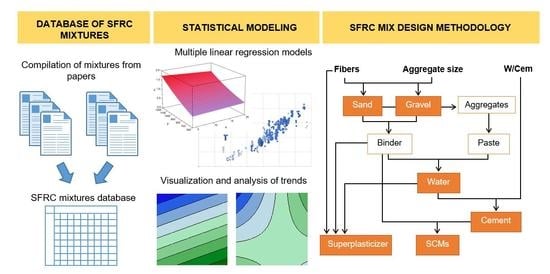Meta-Analysis of Steel Fiber-Reinforced Concrete Mixtures Leads to Practical Mix Design Methodology
Abstract
:1. Introduction
2. Methodology
2.1. Data Collection and Structure of the Database
2.2. Definition of Variables
2.3. Cleansing of Data and Descriptive Analysis
2.4. Statistical Modeling and Contour Plots
3. Preparation and Descriptive Analysis of the Database
3.1. Imputation of Missing Values
3.2. Descriptive Analysis
4. Statistical Models, Interpretation and Discussion
4.1. Coarse-to-Fine Aggregate Ratio
4.2. Coarse Aggregate Content
4.2.1. Fiber Dimensions and Gravel Content
4.2.2. Fiber Volume Fraction and Gravel Content
4.2.3. Maximum Aggregate Size and Gravel Content
4.3. Binder Content
4.3.1. Maximum Aggregate Size and Binder Content
4.3.2. Aggregates and Binder Content
4.4. Superplasticizer Content
5. A Data-Driven SFRC Proportioning Method
6. Conclusions
- Steel fibers are typically used in volume fractions between 0.43% and 1.0%, and in 50% of the cases this is lower than 0.51%. In SFRC mixtures, the cement content typically ranges from 360 to 485 kg/m3, and SCMs are typically used in contents between 40–100 kg/m3. Typical values of the water-to-cement ratio are within the range of 0.36 to 0.50, and in most of the cases, aggregates with a maximum size between 10 and 16 mm are used. Superplasticizers are used in 79% of the cases;
- Regression models have been obtained for the coarse-to-fine aggregate ratio and relative contents of coarse aggregate, binder, and superplasticizer. These models are robust and effective in producing reasonably accurate estimates (R-squared values between 0.76 and 0.92), and their predictive capacity has been checked against a validation dataset. Given their simplicity, robustness, and good fit to data, they constitute a valuable data-driven methodology to guide the proportioning of SFRC mixtures;
- The models obtained encapsulate the complex links between fiber dosage, aggregate contents, fiber dimensions, and maximum aggregate size. High fiber aspect ratios, as well as moderate to high dosages of short fibers, were associated with decreasing the gravel content, and increasing the sand content and the relative paste volume, which was linked to workability and fresh state stability requirements;
- The gravel content of SFRC mixes was found to be practically insensitive to fiber length when the fiber volume fraction was below 0.54%, taking values between 800 and 850 kg/m3. Interestingly, gravel contents within this range were also associated with SFRC mixtures with higher fiber dosages when the fiber length was 40 mm;
- Low binder contents are generally associated with SFRC mixtures in which the sand and gravel contents are not too dissimilar, the coarse-to-fine aggregate ratio being in the range of 0.7–1.3. On the other hand, SFRC mixtures with moderate to high binder contents generally have significantly less gravel than sand;
- The superplasticizer content values in the database used for this study presented significant scatter, because it included some binder-intensive SFRC mixtures and, furthermore, there can be big differences between superplasticizers in terms of their recommended dosage range and optimal dosage. Despite this, the models developed worked well in estimating the superplasticizer content both in conventional SFRC mixtures and the more demanding ones.
Supplementary Materials
Author Contributions
Funding
Institutional Review Board Statement
Informed Consent Statement
Data Availability Statement
Acknowledgments
Conflicts of Interest
References
- Romualdi, J.P.; Batson, G.B. Behavior of Reinforced Concrete Beams with Closely Spaced Reinforcement. ACI J. Proc. 1963, 60, 775–790. [Google Scholar] [CrossRef]
- Romualdi, J.P. The Strengthening of Brittle Materials. Mater. Sci. Eng. 1974, 15, 31–37. [Google Scholar] [CrossRef]
- Shah, S.; Rangan, B.V. Fiber Reinforced Concrete Properties. ACI J. Proc. 1971, 68, 126–135. [Google Scholar] [CrossRef]
- Batson, G. Steel Fiber Reinforced Concrete. Mater. Sci. Eng. 1976, 25, 53–58. [Google Scholar] [CrossRef]
- Naaman, A.E.; Shah, S.P. Tensile Tests of Ferrocement. ACI J. Proc. 1971, 68, 693–698. [Google Scholar] [CrossRef]
- International Federation for Structural Concrete. Fib Model Code for Concrete Structures 2010; Ernst & Sohn: Berlin, Germany, 2013; ISBN 978-3-433-03061-5. [Google Scholar]
- ACI Committee 544. 544.3R-08 Guide for Specifying, Proportioning, and Production of Fiber-Reinforced Concrete; American Concrete Institute: Farmington Hills, MI, USA, 2010. [Google Scholar]
- ACI Committee 544. 544.9R-17 Report on Measuring Mechanical Properties of Hardened Fiber- Reinforced Concrete; American Concrete Institute: Farmington Hills, MI, USA, 2017. [Google Scholar]
- ACI Committee 544. 544.4R-19 Guide for Design with Fiber-Reinforced Concrete; American Concrete Institute: Farmington Hills, MI, USA, 2018. [Google Scholar]
- International Federation for Structural Concrete. Fib Bulletin 79. Fibre-Reinforced Concrete: From Design to Structural Applications; Massicotte, B., Ed.; The International Federation for Structural Concrete: Lausanne, Switzerland, 2017; ISBN 9782883941199. [Google Scholar]
- International Federation for Structural Concrete. Fib Bulletin 95. Fibre Reinforced Concrete: From Design to Structural Applications; Massicotte, B., Mobasher, B., Minelli, F., Plizzari, G., Eds.; The International Federation for Structural Concrete: Lausanne, Switzerland, 2020; ISBN 9782883941427. [Google Scholar]
- Ferrara, L. Fiber Reinforced SCC. In Mechanical Properties of Self-Compacting Concrete. RILEM State-of-the-Art Reports; Springer: Berlin/Heidelberg, Germany, 2014; Volume 14, pp. 161–219. [Google Scholar]
- Yu, R.; Spiesz, P.; Brouwers, H.J.H. Development of Ultra-High Performance Fibre Reinforced Concrete (UHPFRC): Towards an Efficient Utilization of Binders and Fibres. Constr. Build. Mater. 2015, 79, 273–282. [Google Scholar] [CrossRef] [Green Version]
- Ferrara, L.; Faifer, M.; Toscani, S. A Magnetic Method for Non Destructive Monitoring of Fiber Dispersion and Orientation in Steel Fiber Reinforced Cementitious Composites-Part 1: Method Calibration. Mater. Struct. Mater. Constr. 2012, 45, 575–589. [Google Scholar] [CrossRef]
- Ferrara, L.; Ozyurt, N.; di Prisco, M. High Mechanical Performance of Fibre Reinforced Cementitious Composites: The Role of “Casting-Flow Induced” Fibre Orientation. Mater. Struct. 2011, 44, 109–128. [Google Scholar] [CrossRef]
- Garcia-Taengua, E. Using Decades of Data to Rethink Proportioning and Optimisation of FRC Mixes: The OptiFRC Project. In RILEM Bookseries; Springer: Berlin/Heidelberg, Germany, 2021; Volume 30, pp. 827–838. ISBN 9783030584818. [Google Scholar]
- Garcia-Taengua, E. Fundamental Fresh State Properties of Self-Consolidating Concrete: A Meta-Analysis of Mix Designs. Adv. Civ. Eng. 2018, 2018, 1–13. [Google Scholar] [CrossRef]
- Garcia-Taengua, E.; Rocio Marti-Vargas, J. Multivariate Analysis of the Fresh State Parameters of Self-Consolidating Concrete. In Proceedings of the Scc 2016—8th International Rilem Symposium on Self-Compacting Concrete, Washington D.C., WA, USA, 15–18 May 2016; Volume 100, pp. 221–231, ISBN 978-2-35158-156-8. [Google Scholar]
- Hand, D.J.; Mannila, H.; Smyth, P. Principles of Data Mining; MIT Press: Cambridge, MA, USA, 2001. [Google Scholar]
- Walker, E.; Hernandez, A.V.; Kattan, M.W. Meta-Analysis: Its Strengths and Limitations. Clevel. Clin. J. Med. 2008, 75, 431–439. [Google Scholar] [CrossRef]
- Hair, J.F., Jr.; Black, W.C.; Babin, B.J.; Anderson, R.E. Multivariate Data Analysis, 7th ed.; Pearson Education Ltd.: Harlow, UK, 2014; ISBN 9781292021904. [Google Scholar]
- Snellings, R. Assessing, Understanding and Unlocking Supplementary Cementitious Materials. RILEM Tech. Lett. 2016, 1, 50. [Google Scholar] [CrossRef] [Green Version]
- European Committee for Standardization. EN 197-1:2011 Cement—Part 1: Composition, Specifications and Conformity Criteria for Common Cements; European Committee for Standardization: Brussels, Belgium, 2011. [Google Scholar]
- Schafer, J.L. Multiple Imputation: A Primer. Stat. Methods Med Res. 1999, 8, 3–15. [Google Scholar] [CrossRef] [PubMed]
- Harrell, F.E. Missing Data. In Regression Modeling Strategies; Springer: Cham, Switzerland, 2015; pp. 45–61. [Google Scholar]
- Schwertman, N.C.; Owens, M.A.; Adnan, R. A Simple More General Boxplot Method for Identifying Outliers. Comput. Stat. Data Anal. 2004, 47, 165–174. [Google Scholar] [CrossRef]
- Dümbgen, L.; Riedwyl, H. On Fences and Asymmetry in Box-and-Whiskers Plots. Am. Stat. 2007, 61, 356–359. [Google Scholar] [CrossRef]
- Walker, M.L.; Dovoedo, Y.H.; Chakraborti, S.; Hilton, C.W. An Improved Boxplot for Univariate Data. Am. Stat. 2018, 72, 348–353. [Google Scholar] [CrossRef]
- Schmidt, M.; Fehling, E. Ultra-High-Performance Concrete: Research, Development and Application in Europe. ACI Spec. Publ. 228 2005, 51–78. [Google Scholar]
- Bolomey, J. Granulation et Prevision de La Resistance Probable Des Betons. Travaux 1935, 19, 228–232. [Google Scholar]
- Keske, S.D.; Schindler, A.K.; Barnes, R.W. Assessment of Stability Test Methods for Self-Consolidating Concrete. ACI Mater. J. 2013, 4, 385–394. [Google Scholar]
- ACI Committee 544. ACI 544.2R-17 Report on the Measurement of Fresh State Properties and Fiber Dispersion of Fiber-Reinforced Concrete; American Concrete Institute: Farmington Hills, MI, USA, 2017. [Google Scholar]
- García-Taengua, E.; Sonebi, M.; Crossett, P.; Taylor, S.; Deegan, P.; Ferrara, L.; Pattarini, A. Performance of Sustainable SCC Mixes with Mineral Additions for Use in Precast Concrete Industry. J. Sustain. Cem. Based Mater. 2015, 157–175. [Google Scholar] [CrossRef]
- Garcia-Taengua, E.; Sonebi, M.; Taylor, S.; Ferrara, L.; Deegan, P.; Pattarini, A. Compatibility of Superplasticizers with Cementitious Materials. BFT Int. 2014, 80, 44–53. [Google Scholar]
- Fernandez-Altable, V.; Casanova, I. Influence of Mixing Sequence and Superplasticiser Dosage on the Rheological Response of Cement Pastes at Different Temperatures. Cem. Concr. Res. 2006, 36, 1222–1230. [Google Scholar] [CrossRef]
- Agulló, L.; Toralles-Carbonari, B.; Gettu, R.; Aguado, A. Fluidity of Cement Pastes with Mineral Admixtures and Superplasticizer—A Study Based on the Marsh Cone Test. Mater. Struct. 1999, 32, 479–485. [Google Scholar] [CrossRef]
- Alin, A. Multicollinearity. Wiley Interdiscip. Rev. Comput. Stat. 2010, 2, 370–374. [Google Scholar] [CrossRef]
- Hughes, B.P.; Fattuhi, N.I. The Workability of Steel-Fibre-Reinforced Concrete. Mag. Concr. Res. 1976, 28, 157–161. [Google Scholar] [CrossRef]
- Chu, S.H. Effect of Paste Volume on Fresh and Hardened Properties of Concrete. Constr. Build. Mater. 2019, 218, 284–294. [Google Scholar] [CrossRef]
- Chu, S.H.; Jiang, Y.; Kwan, A.K.H. Effect of Rigid Fibres on Aggregate Packing. Constr. Build. Mater. 2019, 224, 326–335. [Google Scholar] [CrossRef]
- Chu, S.H.; Li, L.G.; Kwan, A.K.H. Fibre Factors Governing the Fresh and Hardened Properties of Steel FRC. Constr. Build. Mater. 2018, 186, 1228–1238. [Google Scholar] [CrossRef]
- Grünewald, S.; Walraven, J.C. Parameter-Study on the Influence of Steel Fibers and Coarse Aggregate Content on the Fresh Properties of Self-Compacting Concrete. Cem. Concr. Res. 2001, 31, 1793–1798. [Google Scholar] [CrossRef]
- de la Rosa, Á.; Poveda, E.; Ruiz, G.; Cifuentes, H. Proportioning of Self-Compacting Steel-Fiber Reinforced Concrete Mixes Based on Target Plastic Viscosity and Compressive Strength: Mix-Design Procedure & Experimental Validation. Constr. Build. Mater. 2018, 189, 409–419. [Google Scholar] [CrossRef]
- Ferrara, L.; Park, Y.D.; Shah, S.P. A Method for Mix-Design of Fiber-Reinforced Self-Compacting Concrete. Cem. Concr. Res. 2007, 37, 957–971. [Google Scholar] [CrossRef]

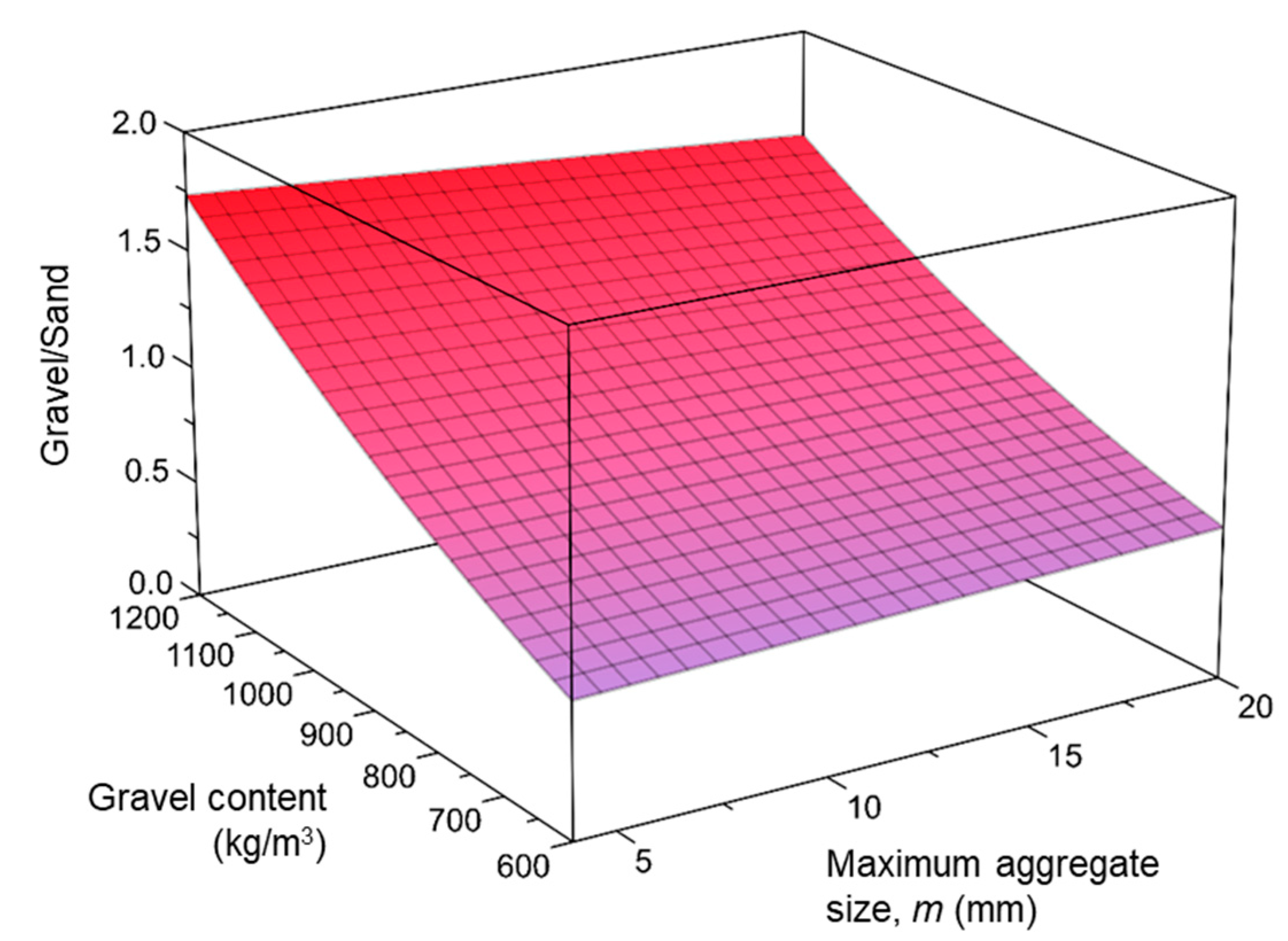
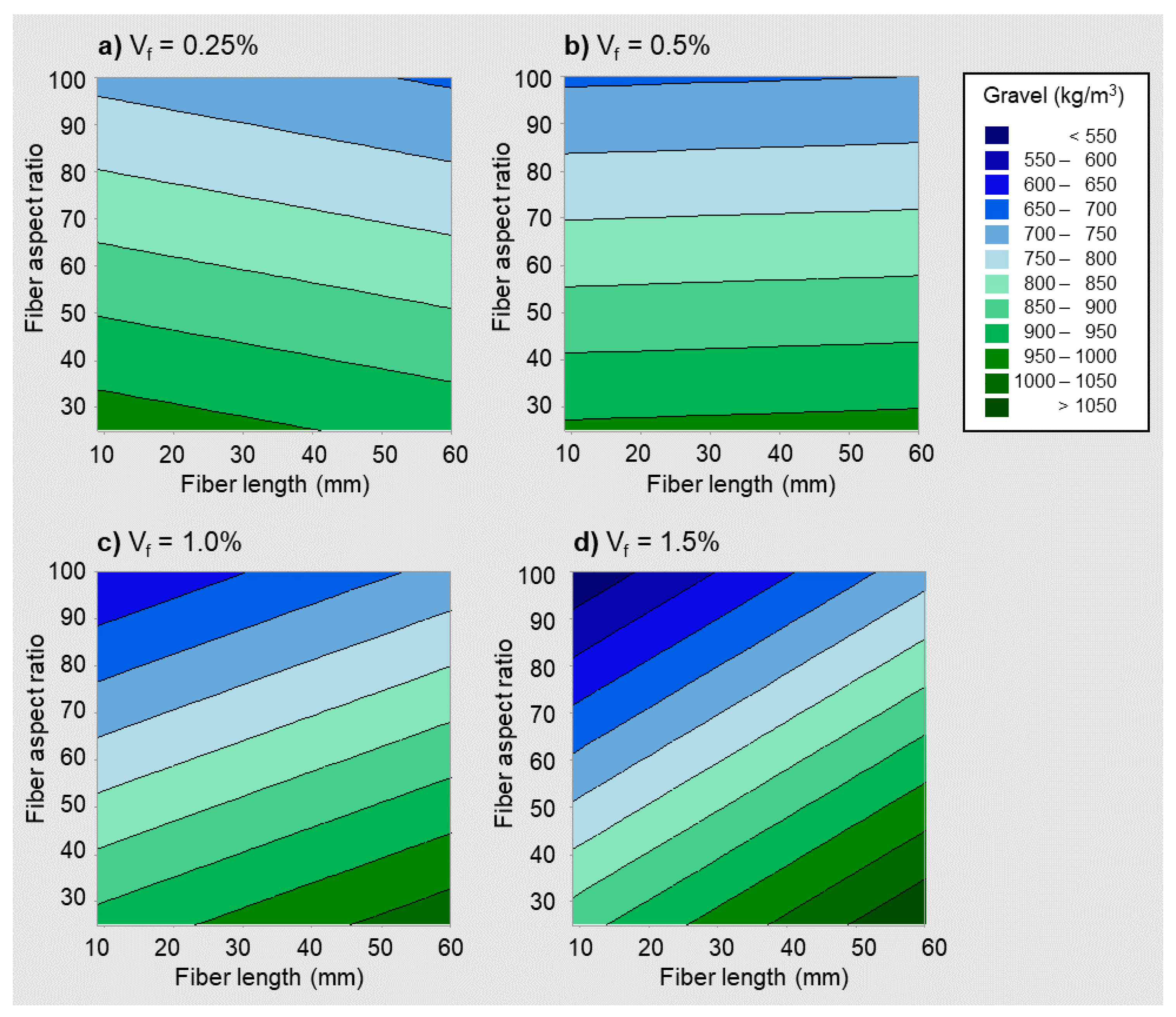
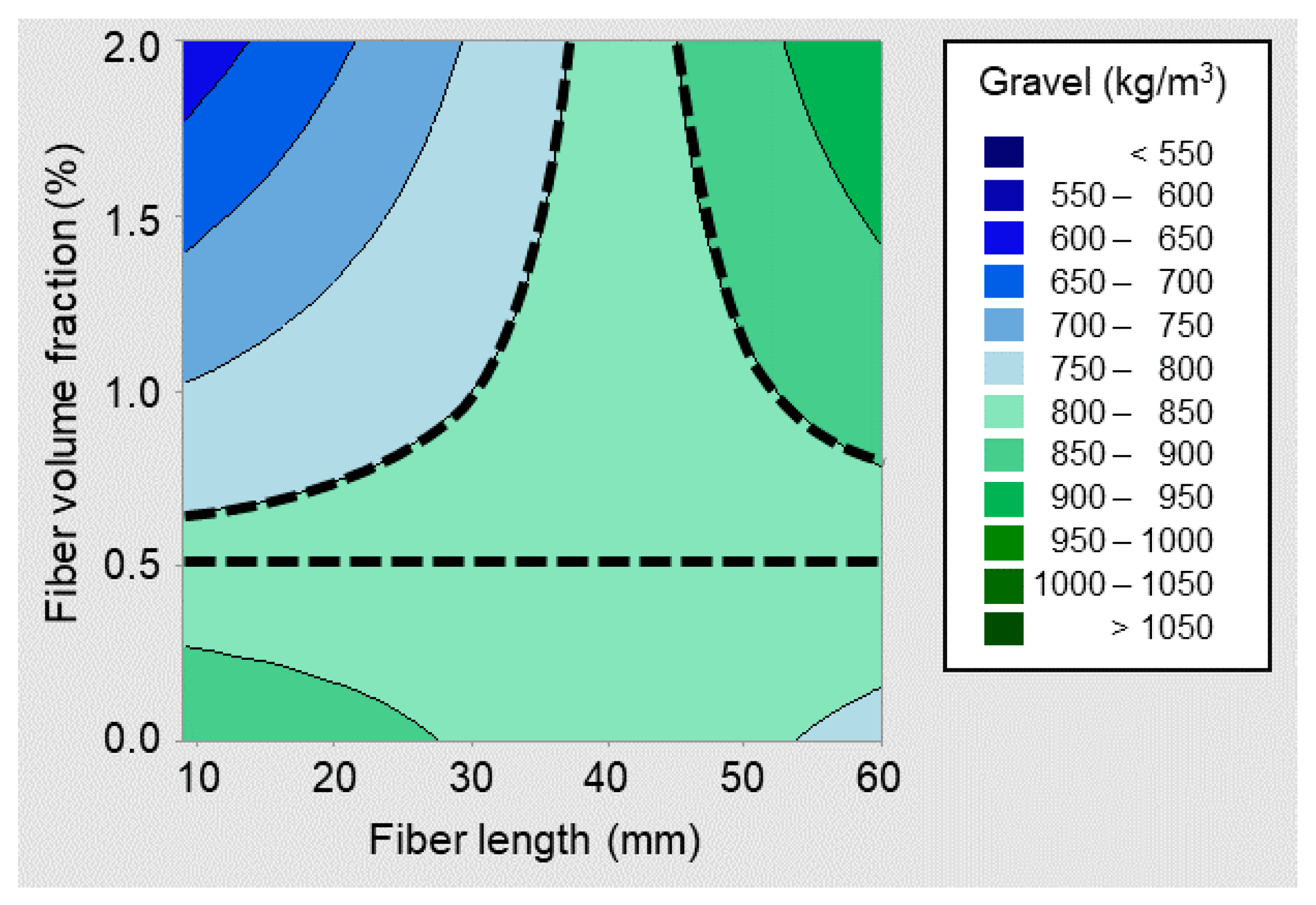
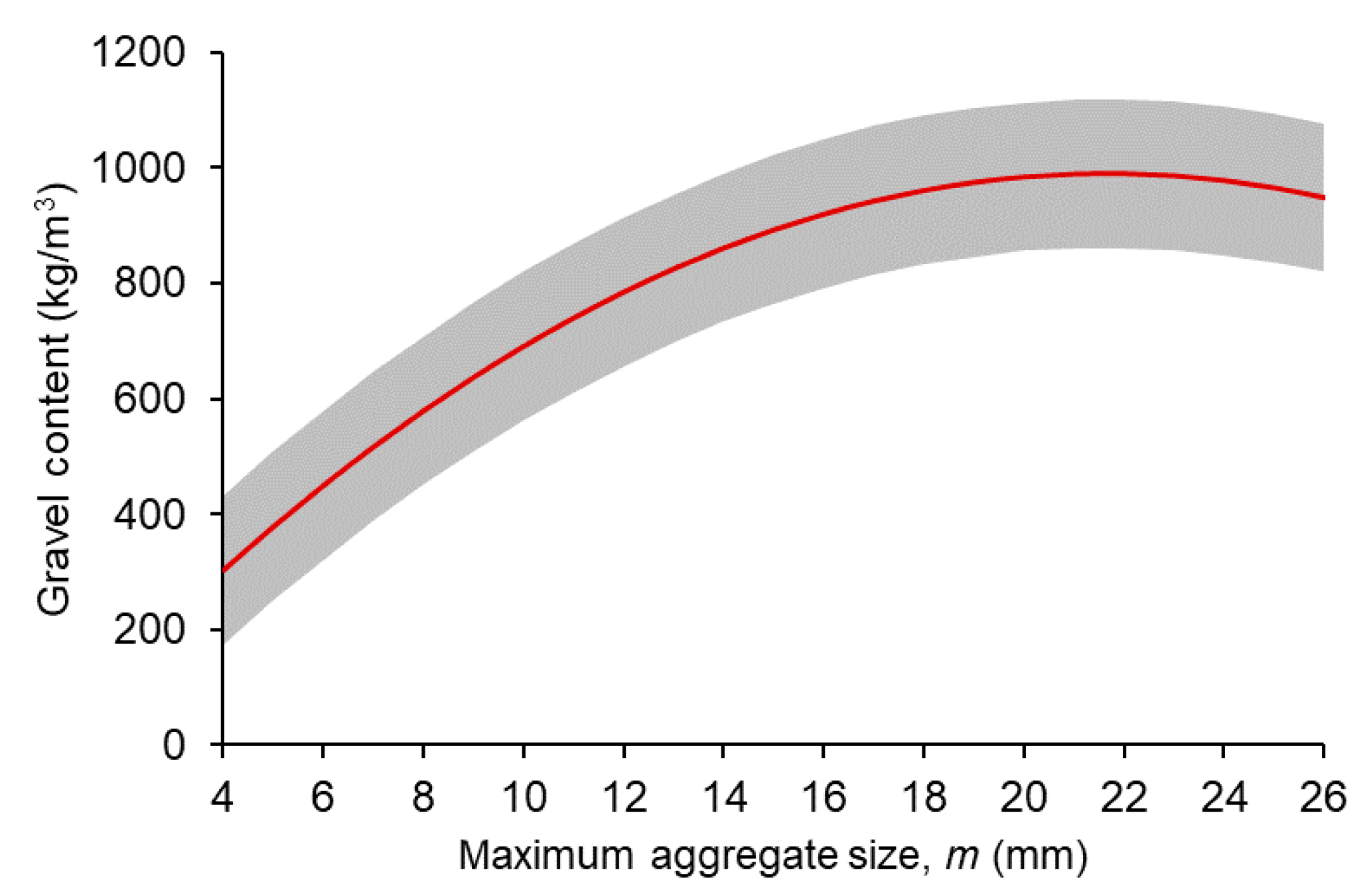
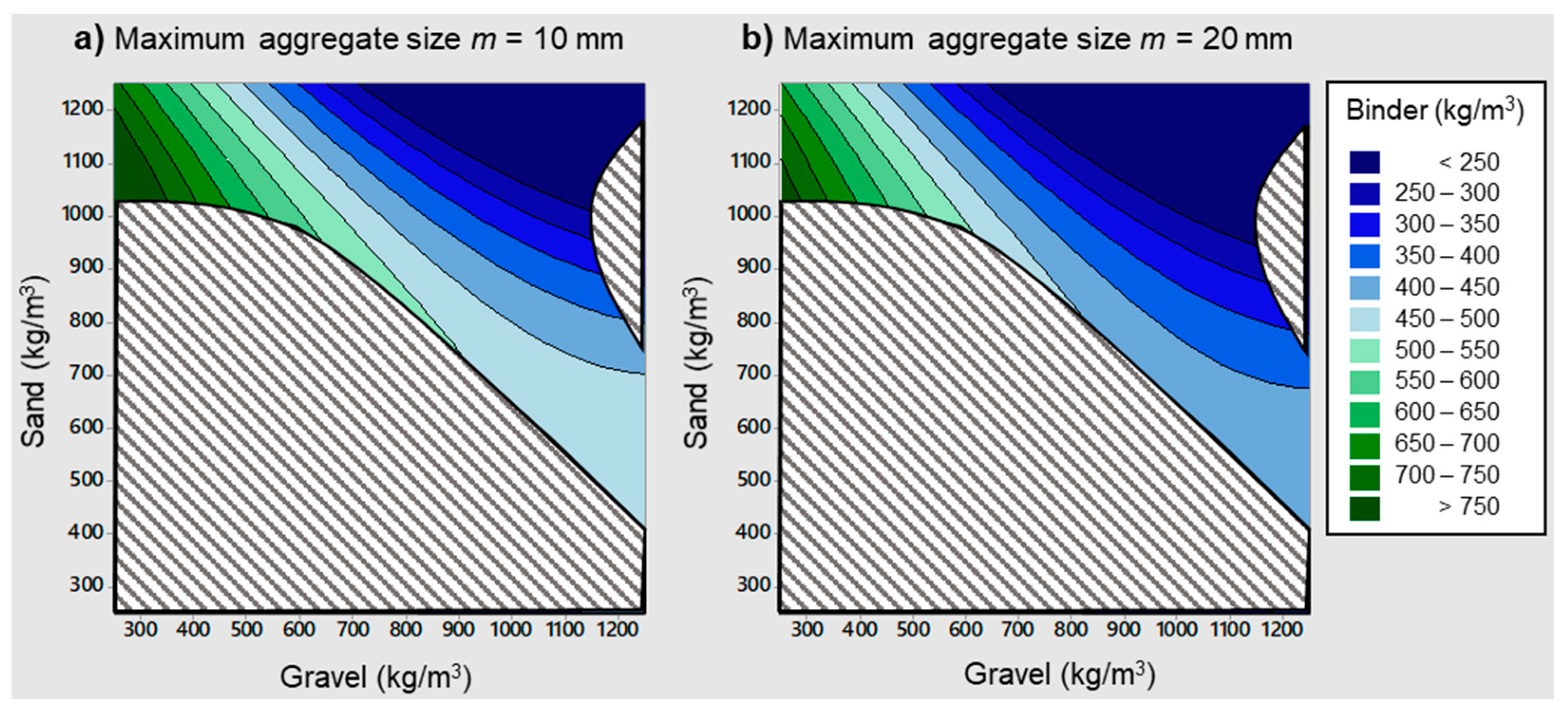
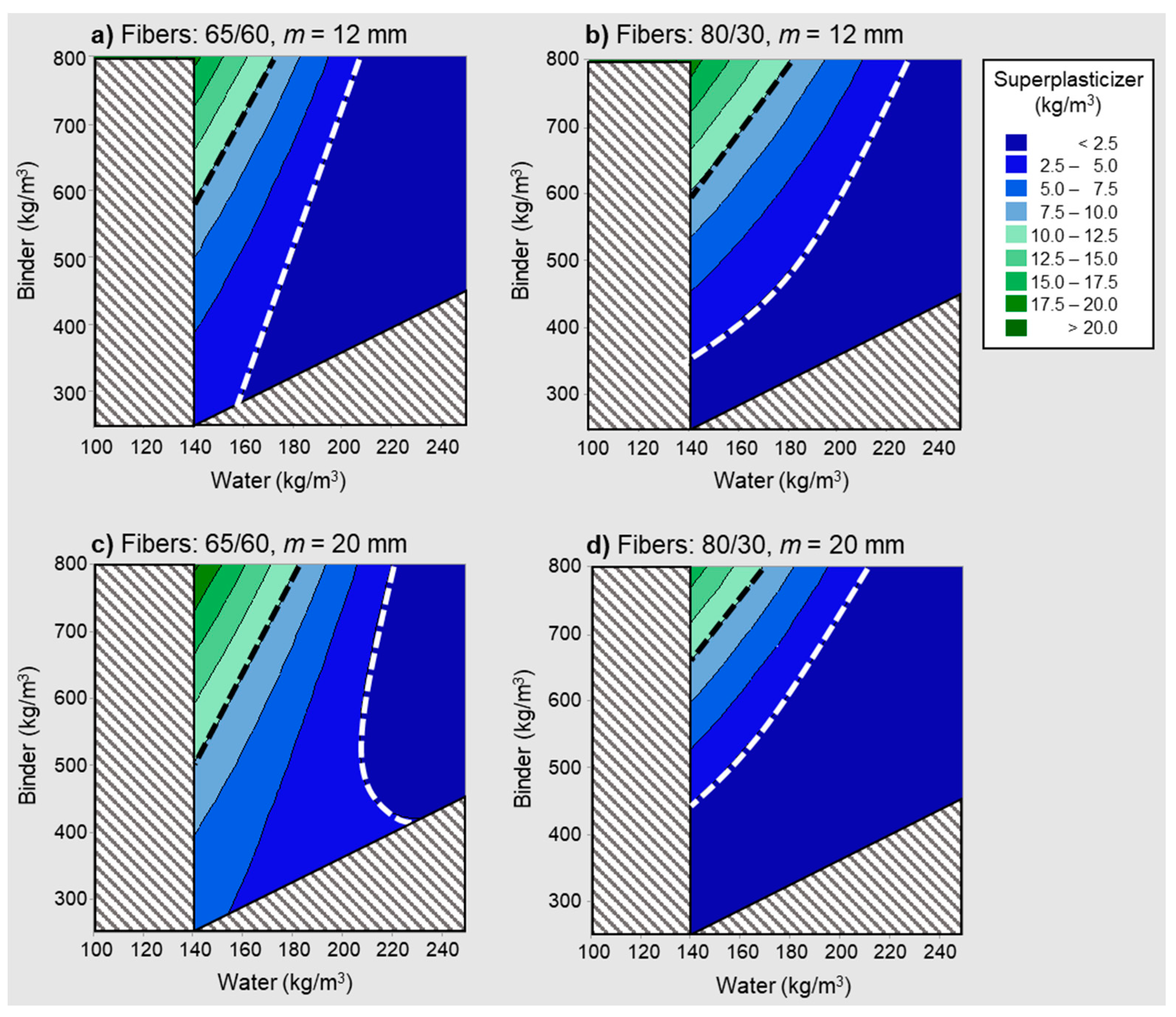
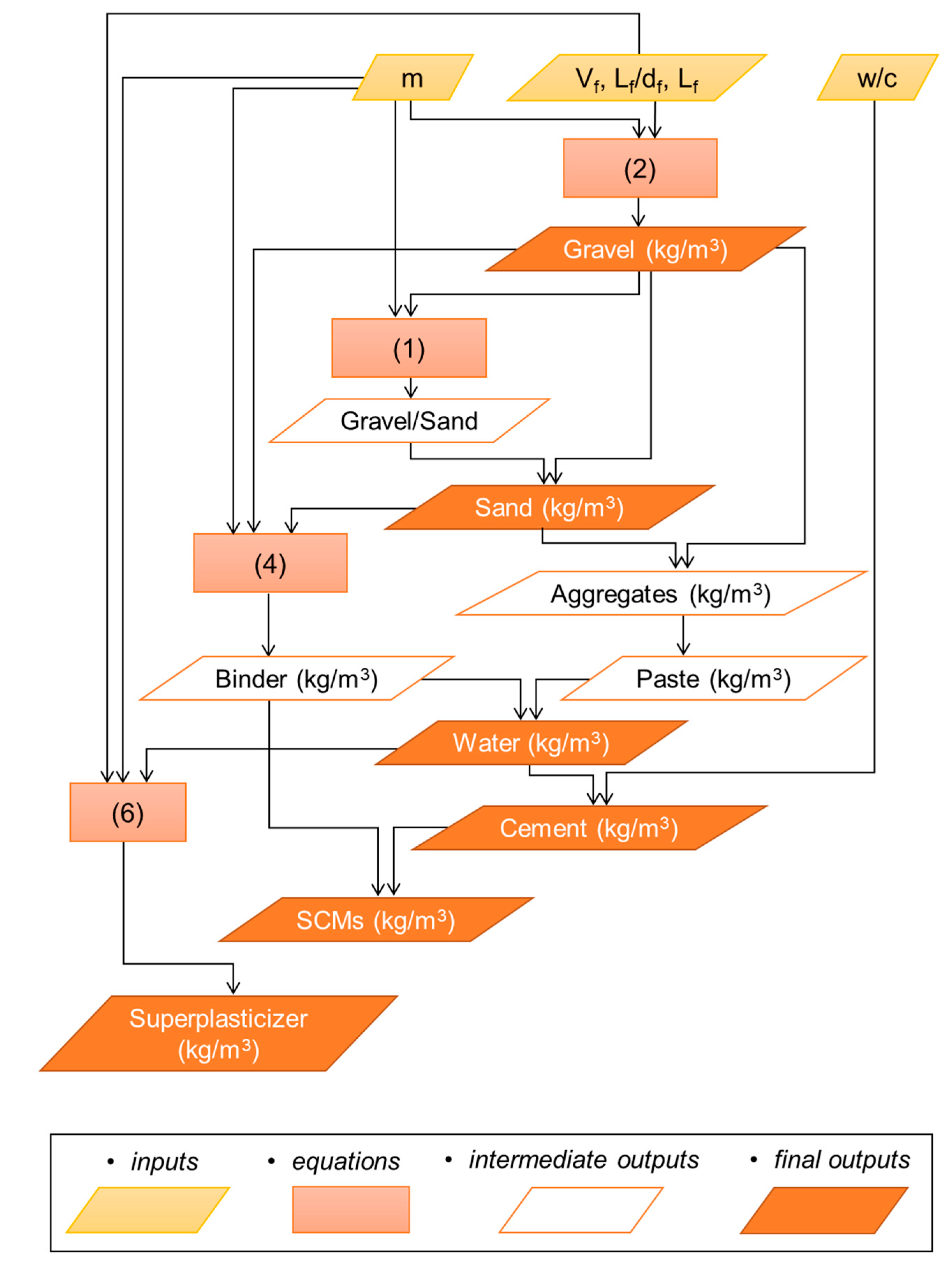
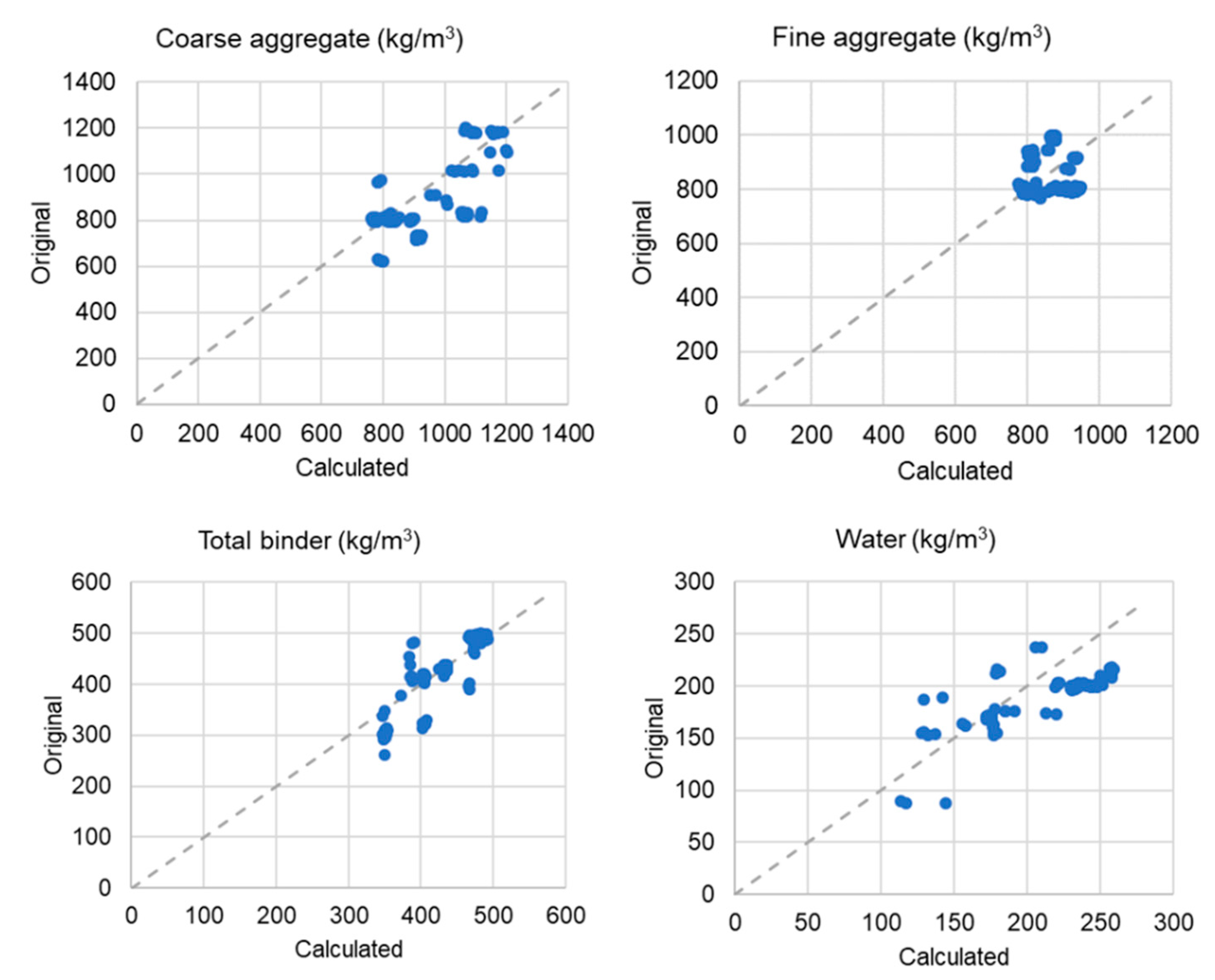
| Variable | Missingness |
|---|---|
| Cement type | 42.1% |
| Maximum aggregate size | 23.9% |
| Superplasticizer dosage | 4.8% |
| Fine aggregate content | 3.2% |
| Coarse aggregate content | 3.2% |
| SCMs content | 2.6% |
| Cement content | 2.6% |
| Parameter | Median | Representative Range | Typical Range | ||
|---|---|---|---|---|---|
| Minimum | Maximum | Minimum | Maximum | ||
| Total binder (kg/m3) | 440 | 270 | 710 | 390 | 550 |
| Cement (kg/m3) | 400 | 325 | 678 | 360 | 485 |
| SCMs (kg/m3) 1 | 60 | 20 | 198 | 40 | 100 |
| Water (kg/m3) | 180 | 140 | 237 | 163 | 203 |
| W/C ratio (non-dimensional) | 0.45 | 0.22 | 0.60 | 0.36 | 0.50 |
| Superplasticizer (kg/m3) 2 | 4.0 | 1.3 | 14.0 | 2.6 | 7.0 |
| Fine aggregate (kg/m3) | 835 | 524 | 1071 | 699 | 914 |
| Coarse aggregate (kg/m3) 3 | 880 | 388 | 1157 | 774 | 999 |
| Max. aggregate size (mm) | 14 | 1 | 20 | 10 | 16 |
| Fiber volume fraction (%) | 0.51 | 0.25 | 2.0 | 0.43 | 1.0 |
| Fiber length (mm) | 45 | 13 | 60 | 30 | 60 |
| Fiber aspect ratio (non-dimensional) | 65 | 38 | 85 | 60 | 70 |
Publisher’s Note: MDPI stays neutral with regard to jurisdictional claims in published maps and institutional affiliations. |
© 2021 by the authors. Licensee MDPI, Basel, Switzerland. This article is an open access article distributed under the terms and conditions of the Creative Commons Attribution (CC BY) license (https://creativecommons.org/licenses/by/4.0/).
Share and Cite
Garcia-Taengua, E.; Bakhshi, M.; Ferrara, L. Meta-Analysis of Steel Fiber-Reinforced Concrete Mixtures Leads to Practical Mix Design Methodology. Materials 2021, 14, 3900. https://doi.org/10.3390/ma14143900
Garcia-Taengua E, Bakhshi M, Ferrara L. Meta-Analysis of Steel Fiber-Reinforced Concrete Mixtures Leads to Practical Mix Design Methodology. Materials. 2021; 14(14):3900. https://doi.org/10.3390/ma14143900
Chicago/Turabian StyleGarcia-Taengua, Emilio, Mehdi Bakhshi, and Liberato Ferrara. 2021. "Meta-Analysis of Steel Fiber-Reinforced Concrete Mixtures Leads to Practical Mix Design Methodology" Materials 14, no. 14: 3900. https://doi.org/10.3390/ma14143900
APA StyleGarcia-Taengua, E., Bakhshi, M., & Ferrara, L. (2021). Meta-Analysis of Steel Fiber-Reinforced Concrete Mixtures Leads to Practical Mix Design Methodology. Materials, 14(14), 3900. https://doi.org/10.3390/ma14143900






